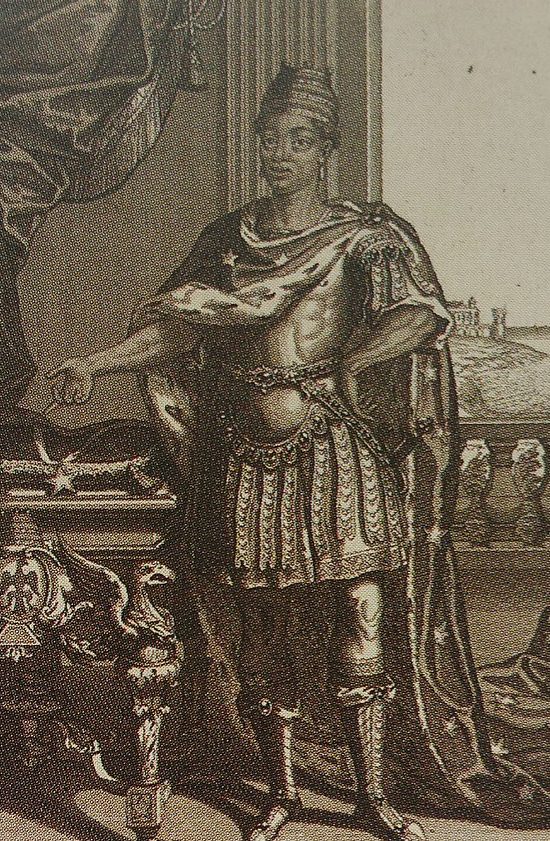The story of Aniaba, an Assinian prince at the court of Louis XIV, illustrates the ambiguity of Franco-African relations in the 17th century—a destiny shaped by diplomacy, illusion, and disillusionment.
A Forgotten chapter of franco-african diplomacy
In the 17th century, the court of Louis XIV glittered with splendor, attracting diplomats, adventurers, and exotic figures. Among them was a young West African prince, Aniaba of Assinie, who moved in the shadow of Versailles’ gilded halls. His meteoric rise—from the son of an Ehotilé king to an officer in the French army—reads like a tale tinged with political manipulation. But who was Aniaba really? A legitimate heir to a throne, or a pawn in France’s colonial ambitions?
Nofi revisits the fascinating story of Aniaba, an exiled prince baptized under the name Louis-Jean Aniaba, who was ushered into high French society only to be sent back to Africa, where his dreams of grandeur would fade into the dust of disillusionment.
An african prince at Versailles
An unprecedented rise in absolutist France
In 1688, the Saint-Louis, a ship belonging to the Compagnie de Guinée, docked in La Rochelle with an unusual cargo: Aniaba and another young man named Banga, presented as nobles from Assinie (present-day Côte d’Ivoire). Delivered to the French as hostages, the young men represented a hope for trade and French expansion in Africa. Aniaba was soon introduced to the court of Louis XIV—a dazzling world where the fashion for Black pages and exotic figures intrigued and captivated onlookers.
His intelligence and adaptability earned him particular attention. He was received by Bossuet, then Bishop of Meaux, who oversaw his baptism. The Sun King himself agreed to be his godfather, giving him the Christian name Louis. This sponsorship was no mere formality: France, eager to establish a foothold on Africa’s west coast, saw Aniaba as a potential tool to further its expansionist ambitions.
Aniaba, instrument of a colonial dream

The fascination with Aniaba was not just aristocratic curiosity. France was seeking to extend its influence over the Gold Coast, coveted by both the Dutch and the British. The presence of an “African prince” at Versailles was part of a broader strategy: to assert French dominance over a region rich in gold and natural resources.
Jean-Baptiste du Casse, governor of Senegal and a skilled strategist, bet on Aniaba to serve as a liaison between France and Assinie. The objective? To groom him to reclaim the throne of his homeland—converted to Christianity and loyal to French interests. In return, France hoped to secure trade privileges, access to gold mines, and a launching point for expanding the slave trade.
During his time in France, Aniaba was more than a curiosity. He was trained in weaponry and became an officer in a cavalry regiment—an exceptional appointment for an African at the time. He received a comfortable stipend and adapted to the codes of the French aristocracy, proving his capacity to navigate this unforgiving world.
Return to Africa: A golden exile turned to disillusion

In 1701, France’s position in West Africa remained fragile. The Sun King, having grown tired of the exotic prince who no longer served a purpose at court, decided to send Aniaba back to Assinie with the hope that he would seize power there. He left France aboard a ship, escorted by missionaries and merchants, under the illusion that he would be welcomed as a sovereign.
But upon arrival, reality struck hard. His presumed royal status was challenged. Power succession among the Ehotilé was matrilineal, and he had no legitimate claim to the throne. The true king, Akassiny, viewed him with suspicion and refused to grant him any authority. Worse still, the French, realizing he would be of no use to them, abandoned him to his fate.
Aniaba found himself isolated, trapped between cultures. Too European to be fully accepted by his people, too African to return to France with honor. Some accounts claim he ended his days as an advisor to a local chief in Togo, under the name Hannibal. Others suggest he quietly returned to Libourne, France. Whatever the truth, he gradually vanished from history, far from the grandeur of Versailles.
A pawn sacrificed on the altar of french ambition
Aniaba’s story is that of a man caught between two worlds, between promise and disillusion. His spectacular rise at Versailles was a smokescreen—a calculated diplomatic operation serving France’s colonial interests. His return to Africa revealed the emptiness of the plan: he was neither legitimate enough to rule, nor European enough to build a future in France.
A tragic figure, Aniaba embodies the broken dreams of an empire that sought to dominate both men and territories. His tale is a stark reminder of the deep disillusionment that often accompanied the encounter between Europe and Africa at the dawn of colonization.
Sources
- Diabaté, Henriette. Aniaba, un Assinien à la Cour de Louis XIV. 1975.
- Chrétien, Jean-Pierre. Histoire de l’Afrique. Flammarion, 2000.
- Blanchard, Pascal & Bancel, Nicolas. Colonisation et propagande : L’image de l’Afrique en France. La Découverte, 2008.
- Sayad, Abdelmalek. La Double Absence : Des illusions de l’émigré aux souffrances de l’immigré. Seuil, 1999.
- Reports from the Compagnie de Guinée (1688–1701), French National Archives.
